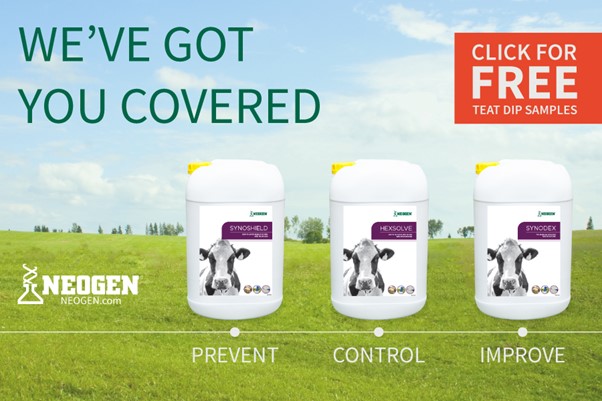



Five key points to consider when selecting teat dip for your herd
Irrespective of the season, never underestimate the importance of good udder hygiene.An effective and consistent milking teat dipping regime, both before and after milking, is vital to optimise cow health and productivity on your farm. Pre milking teat disinfection has been shown to reduce bacterial numbers on the udder and to be most effective against environmental mastitis-causing bacteria such as Escherichia coli and Streptococcus uberis(1), whereas post milking teat dipping is essential to control the spread of contagious mastitis-causing pathogens.

There is a wide variety of teat dip chemistries available in the market to select from, for example, Iodine, Lactic acid, Chlorhexidine, or combinations of these active agents. Similarly, the method of application can vary, spray, dip or foam. There are a wide variety of teat dips, some are specific for pre or post dipping, but all are intended for disinfection. The choice is endless; so how do you select the right one?
This article focuses on the key points that you should consider before you decide which teat dip product to buy. It is essential to establish the major causes of mastitis on your farm, this will help identify the source and guide the selection of udder hygiene products. Running a mastitis pathogen check on milk samples from affected cows is strongly recommended, these are available from many commercial laboratories.
1. Teat condition at your farm
At NEOGEN, we know that soft skin and smooth teat ends are essential to prevent infections and minimise bacteria growth. Cow teats are under constant pressure during the milking process: the weight of the milking cluster, strength of the vacuum, weather conditions, etc. Hence, the first question to answer before selecting a teat dip is to check whether the teat skin is currently in a healthy condition. Dry or chapped teat skin and teat ends showing hyperkeratosis (build-up of skin) requires extra conditioning. When the skin condition is the challenge, a lactic acid-based, high emollient formulation, combined with a gentle disinfectant is highly recommended. Request a free sample of NEOGEN’s Synodex, a ready-to-use teat dip based on lactic acid and a synergistic surfactant blend to improve teat skin condition.
2. Disease pressure at your farm
Mastitis is one of the major diseases that affects the overall health and productivity of your farm. Sub clinical mastitis is not always visible, although it is still affecting your yields and is highly infectious. Clinical mastitis can be just the tip of the iceberg; there could be many cows sub clinically infected. If you have high disease incidence on your farm with bad teat skin condition, a lactic acid-based teat dip is highly recommended to control the spread. Alternatively, a chlorohexidine-based teat dip could be considered on a farm where the herd’s teat skin condition is well maintained, to control the spread of the disease-causing pathogen. Request a free sample of NEOGEN’s Hexsolve, a teat dip based on chlorhexidine for effective control of mastitis causing pathogens.
3. Cleaning properties
A pre-milking teat care product must have excellent cleaning properties. Even all-year-round housed herds require a thorough cleaning to avoid dirt and contaminants being pulled into the milk. Products with a blend of surfactant and disinfectant teat dip should be considered.
4. Product viscosity
The thickness of a product has an impact on the duration of contact on the skin. A high-viscosity teat dip creates a protective layer around the teat and penetrates the orifice and blocks mastitis-causing pathogens from entering the teat canal and the udders. The skin also benefits from an extended contact with products containing high levels of emollients. The formulations from NEOGEN are gentle and hydrating, providing optimum teat skin conditioning. Within the NEOGEN range there are teat dips which offer up to 12 hours of control; these are great where environmental mastitis pathogens are the main cause of cases within the herd.
5. Weather specific formulation
Specific weather conditions require specific teat dip formulations. Summer presents new challenges for managing the health and welfare of your herd. Dry and warm climates deteriorate the teat skin condition leading to a high pathogen load, in turn increasing the risk of mastitis. Flies are another factor that can cause infection and welfare issues during summer. They are vectors for diseases which hamper productivity, increase treatment costs and cause inconvenience for cows and farmers. Request a free sample of NEOGEN’s Synoshield, a teat dip based on lactic acid to prevent deterioration of teat skin condition.
1. Gleeson, D, Flynn, J and Brien, B, 2018. Effect of pre-milking teat disinfection on new mastitis infection rates of dairy cows. Irish Veterinary Journal, 71(1).



